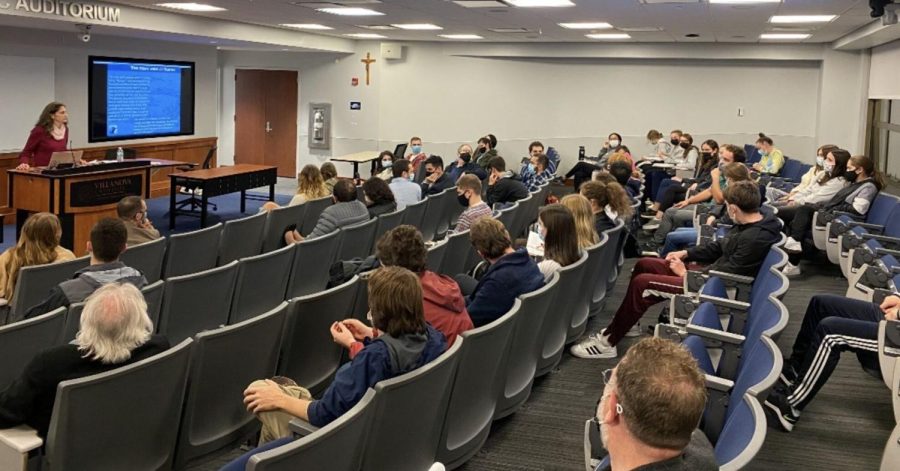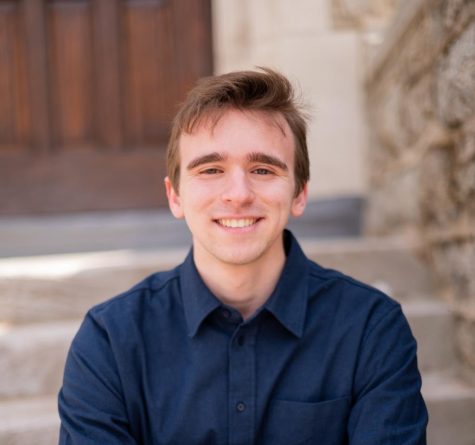Humanities Department’s 2021 Faith and Reason Lecture
Dr. Helena Tomko presents the University’s 2021 Faith and Reason Lecture.
November 3, 2021
Each spring, the University’s Humanities Department holds a Faith and Reason Lecture, provided by a member of the faculty. It’s a beloved tradition nearly as old as the Humanities Department itself. COVID-19 restrictions meant that last spring’s Faith and Reason Lecture went through continual postponements. Finally, though, on the night of Tuesday, Oct. 26, the long-awaited moment had come for this year’s lecture.
The 2021 Faith and Reason Lecture was given by Dr. Helena Tomko, on the topic “What Are You Laughing At?: Humanizing Humor in the Age of Snark.” The lecture was delivered in Bartley Hall’s PwC Auditorium to a nearly-full room of about 50 eager students, alumni and faculty, as well as some outside individuals via livestream.
Tomko has been a professor in the Humanities Department since 2008, and regularly teaches a Humanities course called “Human Person.”
“I always felt that one of the best bits of humanity that we never got around to in ‘Human Person’ is talking about is our sense of humor,” Tomko said. “There’s something glorious about the fact that human beings laugh.”
Tomko has much personal experience researching the topic of humor, as she has been working for the past five years on a book that considers the role of humor in classic Catholic fiction. Through this lecture, she has been able to bring some of her research to the forefront.
In the lecture, Tomko dove into questions about the origin, nature and power of laughter, using examples from sitcoms, films and literature along the way.
Tomko began by describing three classic theories of what makes us laugh: superiority theory, the relief thesis and the incongruity thesis. Superiority theory suggests that humor is based on a shared sense of superiority over another individual. The relief thesis suggests that humor is a release of pent-up nervous energy. The incongruity thesis suggests that humor is a reaction to something being or acting different from our expectations.
However, Tomko felt that something was missing from these classic theories. For example, a baby’s laughter is unlikely to be rooted in a sense of superiority or nervousness, and is clearly about more than a reaction to an incongruity.
“It percolates with burgeoning trust, with joy, with recognition, with affirmation,” Tomko said.
Tomko thus concluded that this type of laughter stands outside the three classic theories. Rather, it is the “laughter of unadulterated dependence.” This laughter is innocent and similar to what we think of as pure joy.
Later in the lecture, Tomko also points out the existence of a similar form of laughter: “laughter of acknowledged dependence.” Acknowledged dependence, according to philosopher Alasdair MacIntyre, is an understanding of one’s relationship with others that is based on the virtues of generosity, truthfulness, and humility. The laughter of acknowledged dependence may not be found in babies, who are below the age of reason, but it is found in moments of kind-hearted laughter between friends.
Both of these forms of laughter stand in opposition to a form of laughter that is more cutting: “the laughter of desperate and defiant independence.” This is the laughter that is found in gossip and mockery. However, Tomko noted that the laughter of defiant independence should not necessarily be wholly eschewed, as it is also found in satire, a necessary element in any free society.
Tomko spent the remainder of the lecture analyzing examples of these forms of laughter in media and the role that these forms of laughter play in our lives.
She left the audience with some final words on the relationship between laughter and love.
“Our laughter has a lot to do with how we understand our responsibilities toward others,” Tomko concluded. “How we laugh sometimes measures how we love.”
Following the lecture, The Villanovan spoke with Tomko to learn more about her thoughts on humor as it relates to contemporary issues.
The past two years have clearly been marred by the COVID-19 pandemic and widespread social unrest. Tomko believes that these factors have contributed to a collective feeling of humorlessness and dissatisfaction, which she refers to as “The Great Souring.”
“I think that the pandemic has brought to the surface things that are sour among us, things that are challenging among us,” Tomko said. “For a lot of us, it’s like a taste in the mouth that won’t go away.”
She clarified that this “souring” is more than just a domestic issue; it’s international.
“I think the particular crisis of the past two years seems to be manifested all over the world in different ways,” Tomko said.
Tomko encourages people to look into alternatives to lessen this collective sense of sourness.
The Villanovan also spoke with Tomko about humor as it relates to the social life of the college student.
“Certain phases of our life lend themselves to certain kinds of humor more,” Tomko said of humor in young adulthood. “Maybe you wouldn’t crack the jokes you would’ve cracked in middle school now, but there’s still sort of that tendency to kind of validate yourself through a joke at somebody else’s expense. And that doesn’t go away as a temptation, I don’t think, at any point in life.”
Humor at Villanova in 2021 appears in various ways. There are, of course, personal moments of humor. You witness this every time you see a group of friends laugh together at a lunch table at the Connelly Center, every time you overhear whispered gossip and snarky remarks at the Falvey Library and every time you walk past a class chuckling at a professor’s joke in Bartley Hall. These moments are all different, but nevertheless involve face-to-face interaction. Face-to-face interaction comes with a sense of responsibility, as there is no anonymity to hide behind.
There are also communal moments of humor, which nowadays mostly come from social media. These moments are often unifying in a positive way, allowing students to bond about shared experiences. When @barstoolvillanova posts a video of hordes of students tripping and falling onto the elevated basketball court at Hoops Mania, it has the effect of immediately uniting thousands of Villanova students in a light-hearted way. This is also true for whenever you see a post poking fun at the University’s portable chair craze, the campus squirrels, the spotted lanternflies and much else.
Still, some communal platforms also have the potential to be destructive. The anonymous posting app YikYak has exploded in popularity at Villanova this semester. The app has served as a public forum for the University, providing endless humor and commentary. However, the app has also been known for being prone to harassment in the past, and at times this semester has not been the friendliest site for students.
While Tomko is unfamiliar with the particulars of the social media landscape among the Villanova student body, she offered general advice about how to use such platforms mindfully.
“Often, if you’re cracking a derisive joke that you’re launching into some app online, you’re acting as if you’re totally independent of the consequences, of the people you’re joking about, and as if there was a sort of no real connection between you and them,” Tomko said. “So I would advocate a return to a sense of acknowledged dependence; you never crack a joke at someone else’s expense without it having some kind of consequence.”
The past two years have been difficult. However, a simple walk through Villanova’s campus or a scroll through Villanova-centric social media accounts show that there is still much humor to be found at the University. If there is one thing to remember, though, it is to be mindful of our humor. Make sure to not succumb to immaturity or to the sourness of our age and allow them to make our humor mean-spirited and derisive. To paraphrase Dr. Tomko, let how we laugh measure how we love.



